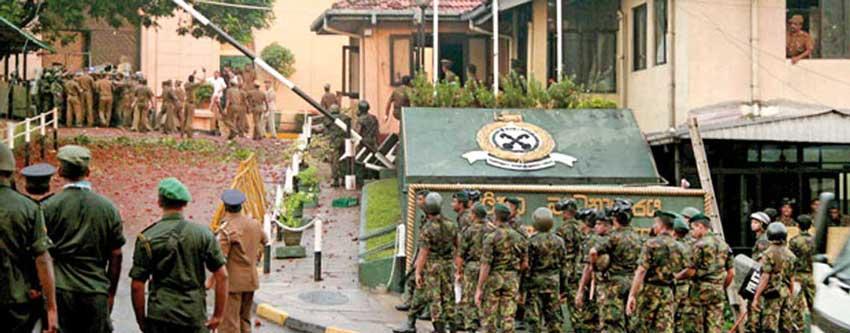14 Nov 2020 - {{hitsCtrl.values.hits}}

Sri Lankan prisons, like prisons in many countries, are severely overcrowded
 According to media reports, as at 10 November 2020, 109 prisoners and two officers have tested positive for COVID-19 at Welikada, Bogambara and Matara prisons. To date, the Government of Sri Lanka (goSL) has taken some positive measures to prevent the spread of COVID-19 in prisons, such as releasing, reportedly, nearly 3000 prisoners in April 2020, the Attorney- General issuing instructions to the police regarding granting bail for particular offences, and more recently the Attorney-General, upon the request of the Minister of Justice, issuing revised instructions to the Acting Inspector General of Police to grant bail to those in remand. However, a review of the current state of prisons illustrates that further action is urgently required.
According to media reports, as at 10 November 2020, 109 prisoners and two officers have tested positive for COVID-19 at Welikada, Bogambara and Matara prisons. To date, the Government of Sri Lanka (goSL) has taken some positive measures to prevent the spread of COVID-19 in prisons, such as releasing, reportedly, nearly 3000 prisoners in April 2020, the Attorney- General issuing instructions to the police regarding granting bail for particular offences, and more recently the Attorney-General, upon the request of the Minister of Justice, issuing revised instructions to the Acting Inspector General of Police to grant bail to those in remand. However, a review of the current state of prisons illustrates that further action is urgently required.
Sri Lankan prisons, like prisons in many countries, are severely overcrowded – there has been an increase in the general prison population from 20, 661 in 2004 to 26,403 as at 3 February 2020. In 2009 the daily average prison population was 27, 823, but accommodation was available only for 11, 707 prisoners - the percentage of overcrowding was therefore 137.7%. In 2018 overcrowding had reduced to 73.3% with 20, 384 prisoners.
One of the main reasons for overcrowding is the large number of pre-trial detainees who comprise 52% of the total prison population. As identified by a Taskforce on Judicial and Legal Causes for Prison Overcrowding and Prison Reform established by the Ministry of Justice, a large number of these persons are on remand due to not being granted bail for bailable, even minor and non-violent offences, or not being able to meet bail conditions. Persons who were unable to pay fines as small as Rs. 2,000 is another group that constitutes a large proportion of the prison population. For instance, in 2012, the number of persons imprisoned for the non-payment of fines was 12, 045, and had increased to 16,111 in 2018, which is 42.4 % and 64.8 % respectively of the total number of persons admitted to prison during those years.
Impact of spread of COVID-19 in prisons
If a large number of prisoners are infected the rather basic prison healthcare system, which also faces a shortage of medical personnel, will not be able to respond. For example, as at 14 Feb 2019, according to the statistics of the Department of Prisons, the ratio of prisoners to Medical Officers was 616:1 at Colombo Remand Prison, 224:1 at Welikada Closed Prison, 105: 1 at Anuradhapura Remand Prison and 88:1 at Galle Remand Prison. Furthermore, if the public healthcare system is overwhelmed, prisoners will likely be low on the priority list to receive treatment.
Since prison visits by families have been suspended due to COVID-19, the Department of Prisons has allowed prisoners to communicate with their families via phone realizing the importance of prisoners maintaining contact with their families during such stressful times. However, suspending prison visits has meant that remandees will no longer receive personal hygiene items such soap, that is needed to prevent the spread of the virus, through family visits. When prisoners are unable to obtain personal items (soap, toothpaste, sanitary napkins), that are not normally provided by prison, via lawful means, i.e. visits by family & friends, it can create a black market in prison for such goods and result in corruption. To address this need ICRC has donated personal hygiene products to prisoners, cleaning products for disinfection and PPE, such as re-usable face masks and face shields, to prison staff.
An outbreak of infection in prisons will also place prison staff, who are not trained to deal with a serious public health crisis, under severe stress, especially since prisons in Sri Lanka are understaffed and prison officers are overworked. According to statistics of the Department of Prisons, as of 31 December 2018, only 3774 guards were employed despite the total number of prison guards in the cadre being 5041. The ratio of male uniform officer to prisoner as at February 2019 was 10:1 at Negombo Remand Prison and 8.1: 1 at Welikada Closed Prison.
According to government statistics, on 7 November only 10632 PCR tests were done, while the Institute for Health Policy recommends around 40,000 tests daily. Given the gap between the number of tests being done and number that is recommended to prevent further spread, it is imperative to take immediate measures to prevent exposure of prisoners to the virus.
Strategies to prevent the spread of COVID-19 in prisons
The formulation of a protocol by the Department of Prisons in consultation with the Ministry of Health on measures to be followed to prevent infection in prisons as well as on reporting and handling persons with symptoms. The World Health Organisation Interim Guidance on Preparedness, Prevention and Control of COVID-19 in Prisons and Other Places of Detention issued on 15 March 2020 should form the template for the protocol.
Appoint a task force consisting of the Superintendent, Chief Jailor, a senior Jailor, Rehabilitation Officer and Medical Officer in each prison to oversee the implementation of these measures.
Use early release measures to reduce over- crowding.
Ensure prisoners have adequate water and soap for personal hygiene and materials to clean the bathrooms.
At least weekly prison visits should be undertaken by Public Health Inspectors (PHI) and the reports/recommendations of the PHI should be made public.
Information on prevention strategies, the state of exposure of prisoners or prison officers to the virus, and action taken thereafter should be made public to prevent rumours and panic.
Early release measures
80 countries worldwide have released prisoners in response to COVID-19. Although it was reported that Sri Lanka too released nearly 3000 prisoners in April 2020, given the severe overcrowding, more early releases are required. Several categories of persons could be considered for early release.
The elderly, i.e. persons over sixty-five, constitute 5% of the prison population. Persons with disabilities, including those who are partially paralyzed and need the assistance of other prisoners to perform basic tasks, like bathing and using toilet, are also found in prisons. These persons too can be considered for release along with those with serious and terminal illnesses. In the event the seriousness and nature of the offence doesn’t allow release, special measures would have to be taken to ensure these prisoners are protected from exposure.
Prisoners with sentences of less than 30 years are eligible for Home Leave if they’ve served a third of their sentence, while those with sentences of more than 30 years must have completed ten years of their sentence to be eligible. Following the successful completion of Home Leave the minister may grant any prisoner license to be released for a portion of their period of imprisonment under the Prevention of Crimes Ordinance. Release through these processes should be expedited.
In 2018 those who were sentenced to less than two years comprised 92% of the prison population. Since the Community Based Corrections Act of 1999 empowers the court to issue a Community Based Correction Order to anyone charged with an offence with a sentence of less than two years taking into account the nature and gravity of the offence, these persons too could be released if they meet the criteria in the Act. As there is a severe shortage of human resources at the Department of Community Corrections, using this method might be difficult because the procedure that is used to assess persons’ eligibility to be issued a community-based correction order is time consuming.
It is critical that the evaluation of eligibility for release in the above-mentioned categories is done according to established objective criteria that is made public in the interests of transparency and to prevent potential abuse of the early release process.
30 Nov 2024 3 hours ago
30 Nov 2024 4 hours ago
30 Nov 2024 7 hours ago
30 Nov 2024 9 hours ago
30 Nov 2024 30 Nov 2024